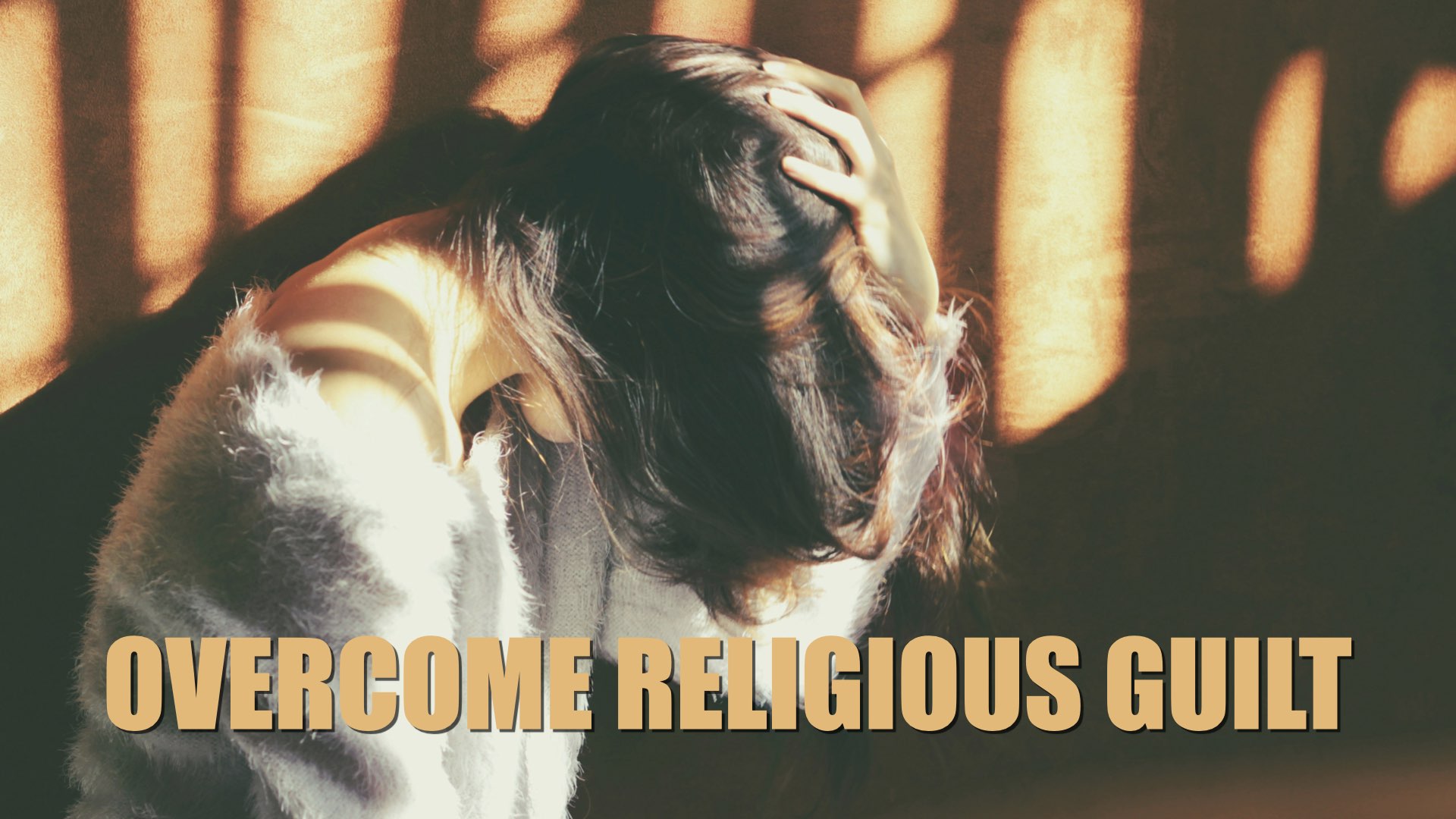Religious guilt can be a deeply ingrained feeling that affects many aspects of life, weighing heavily on self-esteem, relationships, and overall well-being. But overcoming religious guilt is possible. This article explores ways to recognize the roots of unhealthy guilt, and practical steps for understanding and managing it – reframing self-perception and embracing a balanced path toward personal peace and spiritual freedom.
Religious guilt is a complex emotional response that stems from the moral and spiritual values taught within various religious frameworks. Whether rooted in teachings about sin, fear of judgment, or feelings of not measuring up, religious guilt can keep individuals from fully enjoying life and connecting with their own values. It often arises when individuals feel they have violated a religious norm, failed to live up to spiritual ideals, or believe they have disappointed a higher power. Many religions emphasize the concepts of sin, repentance, and redemption. When guilt becomes excessive or persistent, it may inhibit a person’s well-being, overshadowing self-acceptance and personal growth. Understanding religious guilt involves recognizing its roots in religious teachings, community expectations, and personal beliefs.
Common reasons why religious guilt arises
- Fear of Divine Judgment: Many religious systems emphasize consequences for “wrong” behavior, creating a fear of disappointing or angering a higher power.
- Pressure to Conform: Individuals raised in religious communities often feel a strong push to meet high standards of morality and purity, creating a sense of inadequacy if they fall short.
- Identity Confusion: For some, personal beliefs may change over time, yet guilt from deeply embedded religious teachings remains, causing inner conflict.
Overcoming religious guilt is possible. For those wrestling with this complex experience, there is a path forward. But finding balance often requires exploring one’s beliefs, questioning interpretations, and, sometimes, seeking support from therapists, coaches and/or supportive communities that help differentiate between healthy moral awareness and overwhelming self-reproach. Truly understanding the above roots will help you take the first step toward recognizing that religious guilt is learned and can be unlearned. Below you’ll find important and effective steps, exercises & tips to start your journey and decide over your own thoughts and feelings.
Step 1: Cultivate Self-Compassion
One of the most effective ways to address religious guilt is to develop self-compassion. This means treating yourself with the kindness and understanding that you would extend to a close friend. Self-compassion helps in many ways:
- Reduces Self-Criticism: Self-compassion practices, like mindfulness meditation or self-kindness exercises, encourage you to treat yourself gently, which is essential in moving past ingrained guilt.
- Reframes Guilt: By nurturing self-compassion, you can start to see guilt as a part of the human experience rather than a personal failure. This perspective shift helps in viewing guilt with curiosity rather than judgment.
How to Practice Self-Compassion
- Try writing a letter to yourself as if you were comforting a friend experiencing the same guilt. Express understanding and patience in this letter.
- Practice gentle affirmations like, “I am a good person, doing the best I can,” or, “It’s okay to feel conflicted as I explore my beliefs.”
- Engage in mindfulness practices that help you sit with your emotions, allowing you to observe guilt without reacting to it.
Mindful Self-Check-In
Purpose: This exercise encourages you to observe and name feelings of guilt without judgment, helping you become more aware of guilt triggers.
- Instructions: Set aside 5-10 minutes at the end of your day to quietly reflect. Ask yourself, “Did I experience any feelings of guilt today? If so, what was the source?” Without analyzing or criticizing yourself, note any instances where you felt guilt arise. Simply recognize it and thank yourself for noticing.
- Example: “Today, I felt guilt when I didn’t follow a certain routine I used to do. I’m noticing it without judging myself and acknowledging that I’m allowed to make new choices.”
- Reflection: Practicing this check-in regularly can help you become more mindful of guilt and allow you to approach it with curiosity instead of self-criticism.
Step 2: Explore and Define Your Personal Values
For many who experience religious guilt, the guilt often persists even if they no longer identify with certain teachings. One powerful way to navigate this is by defining your own values. By clarifying what matters most to you personally, you can start to discern between values that resonate with your current self and those that may no longer apply.
- Identify Core Beliefs: Make a list of the beliefs or principles you truly value today. Separate these from beliefs you feel were instilled but don’t necessarily align with your authentic self.
- Create a Personal Morality: Construct a framework based on your personal values rather than inherited beliefs. Ask questions like, “What kind of person do I want to be?” or “What behaviors align with my highest self?”
- Use Reflection as a Tool: Regular journaling about your evolving beliefs can help solidify which values you hold dear and reduce the grip of outdated guilt that no longer serves you.
Exercise
Write a “values inventory,” noting down the principles that guide your actions today. This can be a simple list, or you can expand on each value, exploring why it resonates with you. Revisit this inventory when feelings of guilt arise to see if they truly align with your current beliefs.
Step 3: Separate Guilt from Shame
Guilt and shame are often linked but are fundamentally different. Guilt relates to actions (“I did something wrong”), while shame is about identity (“I am a bad person”). Religious guilt often spills into shame, affecting self-worth and self-identity.
- Challenge Internalized Beliefs: Consider where the guilt is directed—is it about an action, or does it reflect deeper feelings of unworthiness? This self-inquiry helps to compartmentalize guilt, keeping it from eroding self-worth.
- Practice Self-Validation: Acknowledge that feeling guilty does not mean you are flawed. Remind yourself that self-worth is not determined by any one action or thought but by the broader way you live and treat yourself and others.
Tip
When feelings of shame arise, practice reframing statements. For example, replace “I am not good enough” with “I am working on being the best version of myself, and that is a journey.” Gradually, these reframes help weaken guilt’s influence on identity.
Exercise: Identifying Guilt Triggers
Purpose: This exercise helps you increase self-awareness by identifying specific situations, words, thoughts, or contexts that trigger religious guilt. By recognizing these patterns, you can begin to understand and address them more consciously.
Instructions:
- Notice the Guilt: Over the next few days, keep a small notebook or notes app handy. Each time you feel a pang of guilt that seems connected to religious beliefs, pause for a moment and jot it down.
- Describe the Trigger: Briefly write what sparked the guilt. It might be a certain word, an interaction, a situation, or even a thought you had. Be as specific as possible without judging yourself.
- Reflect on Patterns: At the end of each day, review your notes to look for common themes. Do certain environments or conversations frequently bring up guilt? Are there specific words or thoughts that often trigger it?
Example:
- Situation: “Heard a phrase about ‘living righteously’ in a conversation with a friend, felt a sudden wave of guilt.”
- Reflection: “Realized that I associate that phrase with strict rules I used to follow, which brings up guilt when I don’t meet those standards.”
Outcome: By identifying these triggers, you can start to see patterns in how religious guilt arises and begin to separate current experiences from past teachings. This awareness is the first step toward gently reframing these moments and responding to them with self-compassion.
Step 4: Build a Supportive Community
Dealing with religious guilt can feel isolating, especially when those around you may not understand or share your struggles. Surrounding yourself with a supportive, nonjudgmental community can make a substantial difference.
- Seek Outlike-Minded Individuals: Support groups, both in person and online, exist specifically to help people dealing with religious guilt or trauma. Hearing others’ experiences can reduce isolation and provide hope.
- Engage with Mentors or Therapists: Therapists experienced in religious trauma or individuals who have worked through similar experiences can provide insight and tools to help you release guilt and build self-acceptance.
- Foster a Nonjudgmental Circle: Try to build friendships with those who accept you unconditionally. These relationships can act as a buffer against guilt-driven thoughts, reinforcing the positive changes you’re making.
Step 5: Embrace Your Own Path Forward
Finally, remember that your journey is unique, and healing is not a one-size-fits-all process. Religious guilt is powerful, but by taking small, consistent steps toward self-compassion, values clarification, and community support, you can gradually break free.
- Give Yourself Permission to Grow: Releasing religious guilt is not about rejecting the past; it’s about embracing a future that reflects who you are now. Honor the lessons you’ve learned, but don’t let guilt dictate your path forward.
- Celebrate Progress: Each time you challenge a guilty thought, validate yourself. Recognize that overcoming religious guilt is a journey and that each step forward, however small, is progress.
Exercises
“Permission to Release” Letter
Purpose: This exercise helps you practice letting go of religious guilt by acknowledging it and giving yourself permission to release it.
- Instructions: Write a letter addressed to yourself, allowing yourself to let go of guilt that no longer serves you. Start with, “Dear [Your Name], I give myself permission to release feelings of guilt related to…” List any specific situations, beliefs, or past experiences that come to mind.
- Example: “I give myself permission to release feelings of guilt about my past decisions that I made with the best information I had at the time. I choose to forgive myself and to trust that I am worthy of self-compassion.”
- Reflection: Reread the letter whenever guilt resurfaces, as a reminder of your commitment to self-compassion and healing.
Values Aligned Visualization
Purpose: This visualization exercise helps you imagine what life looks and feels like when aligned with your personal values, rather than guided by guilt.
- Instructions: Close your eyes and take a few deep breaths. Picture yourself living in a way that fully reflects your own values, without the influence of guilt. Imagine the choices you make, the feelings you experience, and how you interact with yourself and others. Focus on the sense of peace and freedom this brings.
- Example: Picture yourself making decisions confidently based on kindness and integrity, and imagine the relief of knowing you are acting in alignment with your true self.
- Reflection: After the visualization, write down any feelings or insights you noticed. This practice can help reinforce a vision of life that aligns with personal growth and authentic values.



